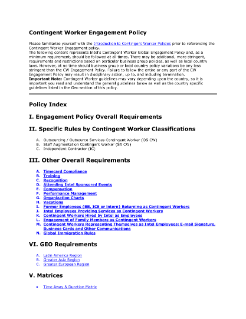Contingent Worker Engagement Policy
Please familiarize yourself with the Introduction to Contingent Worker Policies prior to referencing the Contingent Worker Engagement policy. The following content represents Intel's Contingent Worker Global Engagement Policy and, as a minimum requirement, should be followed at all times. There may be additional, more stringent, requirements and restrictions based on particular business group policies, as well as local country laws. However, at no time should business group or local country policy variations be any less stringent than the CW Engagement Policy. Failure to follow the entire or any part of the CW Engagement Policy may result in disciplinary action, up to, and including termination. Important Note: Contingent Worker guidelines may vary depending upon the country, so it is important you read and understand the general guidelines below as well as the country specific guidelines listed in the Geo section of this policy. Policy Index I. Engagement Policy Overall Requirements II. Specific Rules by Contingent Worker Classifications A. Outsourcing / Outsource Services Contingent Worker (OS CW) B. Staff Augmentation Contingent Worker (SA CW) C. Independent Contractor (IC) III. Other Overall Requirements A. Timecard Compliance B. Training C. Recognition D. Attending Intel Sponsored Events E. Compensation F. Performance Management G. Organization Charts H. Vacations I. Former Employees (BB, ICE or intern) Returning as Contingent Workers J. Intel Employees Providing Services as Contingent Workers K. Contingent Workers Hired by Intel as Employees L. Engagement of Family Members as Contingent Workers M. Contingent Workers Representing Themselves as Intel Employees: E-mail Signature, Business Cards and Other Communications N. Global Immigration Rules VI. GEO Requirements A. Latin America Region B. Greater Asia Region C. Greater European Region V. Matrices • Time Away & Duration Matrix I. Engagement Policy - Overall Requirements Policy definitions/terminology can be found here. Overview: The sponsor owns the engagement with a Staff Augmentation (SA) worker while they are on assignment at Intel. For Outsourced (OS) CWs, the sponsor is responsible to oversee the Supplier’s performance to Intel expectations and the supplier’s compliance with Intel Global Contingent Workforce Policies. The Sponsor also serves as the first point of contact for the supplier to address any worker-related escalations or queries. Intel engages with third party companies, called Suppliers that employ individuals who are assigned to Intel as CWs to perform specialized services, temporarily augment Intel’s workforce or assist Intel with maintaining a flexible workforce where resource requirements fluctuate with demand. Typically there is a contract between Intel and the Supplier that describes the scope of work and services to be performed by the CWs. As the employer, the Supplier is responsible for paying the CWs their compensation, providing benefits, and withholding and paying taxes. The Supplier is also responsible for hiring, firing and managing CW performance and disciplinary issues, including those arising from Intel assignments. Intel may require the Supplier to remove a CW from an Intel assignment as long as this is specified in the contract between Intel and the Supplier. An Intel employee cannot require that a supplier hire any candidate as a contingent worker whether SA or OS. SA CWs must go through the current onboarding process and for OS CWs must go through supplier’s selection and hiring process. What is the risk associated with CWs engagement? According
